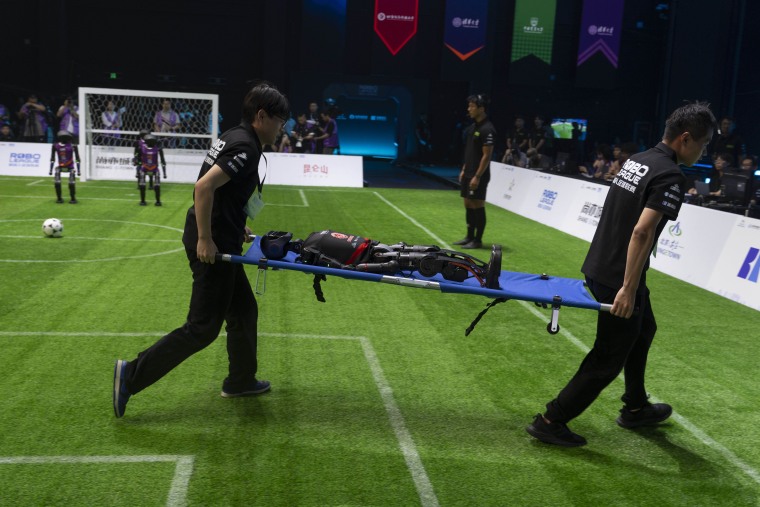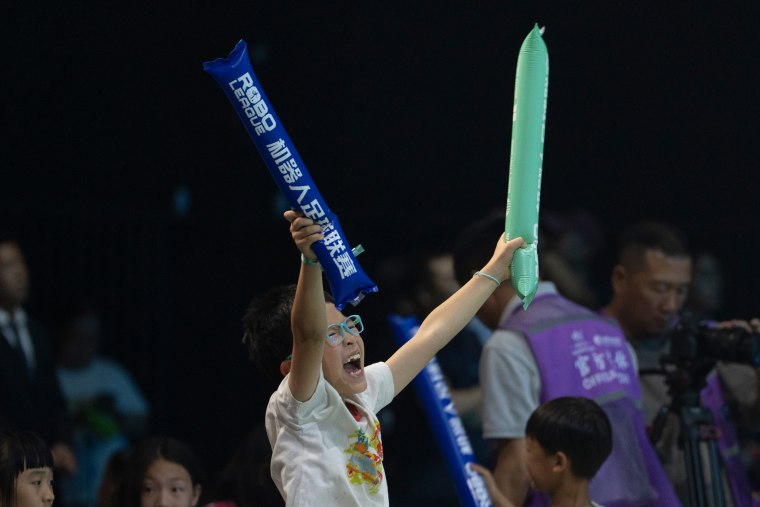Humanoid robots waddled, stumbled, and occasionally face-planted their way through a 3-against-3 soccer tournament in Beijing on Saturday that looked more like the first day of little league than the rise of a robotic Lionel Messi.
Pile-ups were frequent as players toppled over each other in slow-motion collisions, goals were left open, and defending appeared optional. Some robots hogged the ball, others struggled to stay upright, and two or three had to be loaded onto a stretcher and carried off the field.
While the play was absurd, the tech powering it was anything but.
Each team operated fully autonomously, driven by AI, with no human intervention or supervision — an impressive breakthrough somewhat masked by the slapstick spectacle playing out on the field.
Equipped with advanced visual sensors, the child-sized robots were able to identify the ball and navigate the field with some halting agility. They were also designed to stand up on their own after falling, though some did require the help of biological humans, including one who was dragged off the field after tipping over near the goal.
And beneath the bloopers is a country investing tens of billions of dollars and racing to extend its lead in the field of next-gen robotics.
China’s robotics market is projected to grow at an annual rate of 23%, reaching $108 billion by 2028—up from the $47 billion it currently invests, according to research published by Morgan Stanley. By 2050, China is expected to have 302.3 million humanoid robots in use, far ahead of the U.S. at 77.7 million, added the report, noting these would likely be used for “repetitive, simple, and structured work,” like in factories.
“It is becoming apparent that national support for ‘embodied AI’ may be far greater in China than in any other nation, driving continued innovation,” said Sheng Zhong, Morgan Stanley’s Head of Industrials Research. “In our opinion, China’s lead in AI-robotics may need to widen before rivals, including the U.S., pay closer attention.”

Sport is becoming a key part of China’s push as a proving ground for the tech.
In April, A total of 21 humanoid robots recently competed alongside humans in a half-marathon in Beijing, though only six managed to finish. Saturday’s soccer match also served as a preview for the upcoming 2025 World Humanoid Robot Games, which China will host in Beijing from August 15–17. The event will feature 11 robot sports, including gymnastics, track and field, and football.
Cheng Hao, founder and CEO of Booster Robotics — the company that supplied the robot players at Saturday’s soccer tournament — said that sports competitions are a testing ground for humanoid robots. Their successes and stumbles on the field help accelerate the development of both algorithms and integrated hardware-software systems.
He also explained that safety is a core concern about humanoid robots.
“In the future, we may arrange for robots to play football with humans. That means we must ensure the robots are completely safe,” Cheng said, referring to a perceived risk that a heavy robot could fall on and injure a human athlete, for example.
“A robot and a human could play a match where winning doesn’t matter, but real offensive and defensive interactions take place. That would help audiences build trust and understand that robots are safe,” he said.

Ironically, China’s humanoids may be more entertaining than their human counterparts.
With the men’s national team languishing at 94th in the FIFA rankings and likely to miss out on the next World Cup, the robots at least know how to put on a show — and score.
In the final, Tsinghua University’s THU Robotics defeated China Agricultural University’s Mountain Sea team 5–3 to take the championship. No shortage of goals, and no complaints from the cheering crowd.



